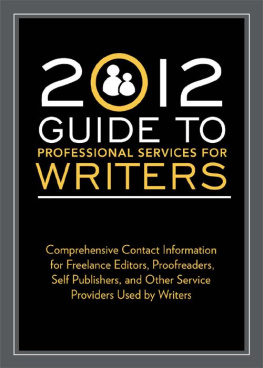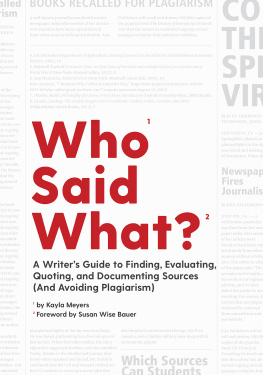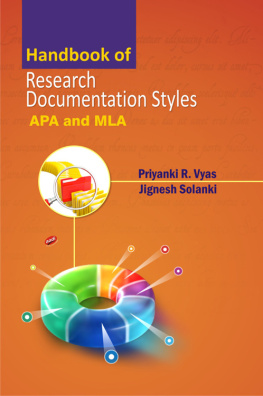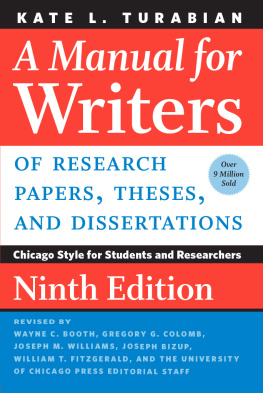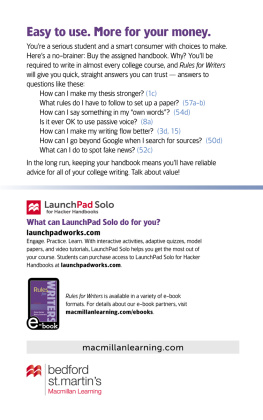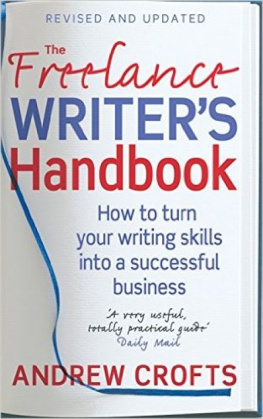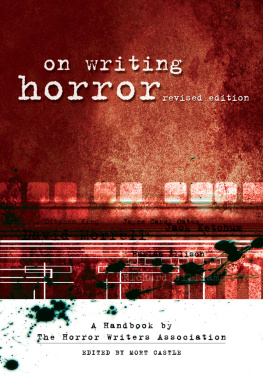MLA Handbook
Ninth edition

The Modern Language Association of America
New York 2021
2021 by The Modern Language Association of America
Published by The Modern Language Association of America
85 Broad Street, Suite 500, New York, New York 10004-2434
www.mla.org
All rights reserved. MLA and the MODERN LANGUAGE ASSOCIATION are trademarks owned by the Modern Language Association of America. Except as allowable by applicable copyright law, written permission from the publisher is required to reproduce or distribute MLA copyrighted material. For permission requests, e-mail .
To order MLA publications, go to mla.org/books. For wholesale and international orders, see mla.org/Bookstore-Orders.
Library of Congress Cataloging-in-Publication Data
Name: Modern Language Association of America.
Title: MLA handbook / Modern Language Association of America. Other titles: MLA handbook for writers of research papers.
Description: Ninth edition. | New York, New York : The Modern Language Association of America, 2021. | Includes bibliographical references and index.
Identifiers: LCCN 2020039581 (print) | LCCN 2020039582 (e-book) | ISBN 9781603293518 (paperback) | ISBN 9781603295611 (hardcover) | ISBN 9781603295628 (spiral bound) | ISBN 9781603293525 (EPUB)
Subjects: LCSH: Report writingHandbooks, manuals, etc. | ResearchHandbooks, manuals, etc.
Classification: LCC LB2369 .M52 2021 (print) | LCC LB2369 (ebook) | DDC 808.02/7dc23
LC record available at https://lccn.loc.gov/2020039581
LC e-book record available at https://lccn.loc.gov/2020039582
Contents
Preface
We at the Modern Language Association are proud to bring you this ninth edition of the MLA Handbook, a publication that has for more than forty years helped writers produce credible research projects and clear prose.
The MLA, though, is many things besides MLA style. It was founded in 1883 as an organization representing language and literature researchers and teachers. In addition to publishing books that support their teaching, we provide opportunities for members to share their researchin PMLA, the premier journal in language and literary studies, for example, and at our annual convention and other events.
Teachers who want ideas about how to teach contemporary Latin American literature, Wuthering Heights, digital literacy, or young adult literature can find the help they need in books we publish. Our members assemble resources to collaborate with one another on our online network, MLA Commons, and they provide professional development for new scholars and higher education administrators through workshops and seminars we sponsor.
Our members work together to strengthen humanities education and research. They advocate for fair working conditions for college teachers and for better learning environments for students.
The MLA exists to support learningat every level. MLA resources serve the high school student who seeks guidance on evaluating sources and avoiding plagiarism, the college student who uses our textbooks to learn a language, and the faculty member who wants new ways to teach. Our work goes far beyond MLA style. Check us out at mla.org.
Acknowledgments
We are grateful for the questions, comments, and suggestions received from readers who use MLA style every day. Hearing from you on the MLA Style Center, on Twitter, by e-mail, at workshop and webinar Q&As, at conferences, and during the various stages of review helped shape this edition in important ways. Thanks are due also to the various reviewers who provided feedback on drafts of this handbook.
The following MLA staff members contributed to the writing, editing, design, and production of this edition of the MLA Handbook: Judith H. Altreuter, Zahra Brown, Susan Doose, Angela Gibson, Laura Kiernan, Barney Latimer, Sara Pastel, Jennifer A. Rappaport, Kevin Romoser, Michael Simon, Leighton Snyder, Erika Suffern, and Joseph Wallace. The handbook benefited also from the insights of various freelance editors and indexers, including Aileen B. Houston, Erika Millen, Do Mi Stauber, Dana Symons, and Megan J. W. Zid.
Introduction
Building confidence in the information and ideas we share with one another is perhaps more important today than ever before, and for nearly a century it has been the driving principle behind MLA style, a set of standards for writing and documentation used by writers to find and evaluate information, alert their audience to the trustworthiness of their findings through citation, and shape the expression of their ideas in conversation with others. What we call MLA style has never been a static method, instead changing over time to meet the needs of writers. Its goals, however, have generally remained the same since the appearance of the first officially published edition (titled the MLA Style Sheet) in 1951: establishing uniform standards for documentation and citation, encouraging the widespread adoption of those standards by writers, and instructing students. This edition carries forth those goals, updating and expanding the MLAs long-standing guidance on paper formatting, prose mechanics, quoting and paraphrasing, in-text references, and the list of works cited.

The MLA template of core elements.
The core elements presented in the MLA template are numbered from 1 to 9 and are as follows: author, title of source, title of container, contributor, version, number, publisher, publication date, and location. Items three to nine are marked container.
The MLAs method for creating bibliographic entries has, however, changed significantly over time. This edition retains the MLAs unique system of documentation, established in the eighth edition of the handbook in 2016. Entries in the list of works cited are created using a template of core elementsfacts common to most sources, like author, title, and publication datethat allows writers to cite any type of work. Instead of asking writers to document a work by first identifying its publication format (for example, book or journal article) and then applying a formula for citing that format, the MLAs method asks writers to evaluate sources using a comprehensive set of standard criteria and then to create bibliographic entries based on that evaluation. Source evaluation and the development of information literacy are therefore central to the MLAs system of documentation. Given that it is flexible enough to cite any type of source, it is also applicable to different kinds of works in various disciplines and to new and rarely encountered types of sources.
This edition goes much further, however, in explaining the system of documentation and other aspects of MLA style, and it does so in response to feedback from readers like you. We regularly receive questions and suggestions through the online MLA Style Center. Although feedback from style users has always shaped editions of the MLA Handbook, this edition was created in direct, sustained dialogue with the instructors, librarians, professional writers and editors, and students around the world who use MLA style every day. We heard calls from many of you for a more comprehensive resource with more examples, a reorganized handbook where information could easily be found, and explanations of the documentation system that responded to the many questions you had while using it. We also sought targeted feedback from reviewers about every aspect of this handbook, from which sections to include and how to organize them to the diversity of examples and the clarity of instruction. Above all, we aimed to strike a balance between providing guidelines for those who want them and establishing a method that gives writers discretion to cite sources in ways that work best for their projects. This edition is meant to serve as a reference guide and textbook for anyone using MLA style.


